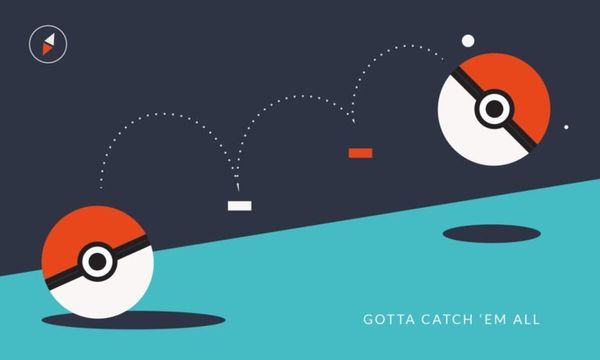As you probably have heard, Nintendo has partnered with game developer Niantic to launch a wildly popular game for iOS and Android called Pokémon GO. The game has already reached over 21M daily active users, dominated the in-game purchasing market, and players are spending more time in the game than on Facebook. It even stopped traffic in Central Park as players abandoned their cars to chase after a rare water Pokémon that had appeared in the vicinity.
Rather than emulate existing Pokémon games for Nintendo’s handheld devices [1], this game uses AR (augmented reality) to place your character in a map that is modeled after the real world. From time to time, wild Pokémon will appear on your map — when you tap on them, you are taken to a feed from your phone’s camera and you see the Pokémon superimposed on top of whatever is in front of you. This is the AR piece of the game and it means that other people playing the game can also “see” the same Pokémon you’re looking at if you’re both in the same location
There’s a lot to say about the game but I thought I’d focus on what designers, PM’s and makers can learn from the game’s popularity.
1. Variable / Intermittent rewards
As games go, Pokémon GO is pretty boring most of the time. Your in-game character only moves when you move in real-life, so if you’re sitting at home or at work, not much happens. By walking past Pokéstops, which are mapped to millions of real landmarks, you can earn Pokéballs, and occassionally, better rewards like Pokémon eggs and incubators for those eggs. Every so often, a wild Pokémon appears and you can “throw” your Pokéballs at them by swiping up on the screen to catch it. Pokémon are not distributed equally either, there are common Pokémon, uncommon ones, and super rare ones that only appear once in a blue moon (hence the traffic jam for the Vaperon).

I’ve written before about the power of intermittent rewards. They are actually the most powerful reward mechanic for reinforcing behavior in mice and clearly a similar dynamic is at play here. Both for collecting items and for catching Pokémon, variable rewards play an important role. Due to the way you acquire items from the Pokéstops (by spinning a wheel) and how wild Pokémon appear (regularly but at unpredictable intervals)
2. Completion
As anyone who has been exposed to the Pokémon theme song knows, one of the primary goals of every Pokémon trainer is to “catch ’em all”. The franchise started out with 150 Pokémon but has ballooned to over 700 over time as new games introduced new Pokémon. Fortunately, there are only 151 to catch in Pokémon Go and the rarity of certain Pokémon means that players will be working hard to complete the set. Each Pokémon you discover is added to your Pokédex, with grayed out entries making it very clear that you’ve got more to go.

3. Cooperation and Competition
Like World of Warcraft, or Destiny, this game is better with others. But unlike a raid in Warcraft which requires coordinating several players of high skill and hours of free time, Pokémon GO is more like a casual game ala Words with Friends and can be “played” with just about anyone, anytime, anywhere. By coordinating the use of lures, which draw Pokémon to a particular Pokéstop, a small team of players can quickly catch many more Pokémon than they can alone. And since lures can be seen all players in the nearby area, more players might come by to get on the action, which increases the chances that a rare Pokémon might occur.
But there’s also room for competition in this game. After you reach Level 5, you can start battling in Pokémon Gyms, which are scattered throughout the area like Pokéstops, but less common. If you’ve got a strong Pokémon team and a great battle skills, you can become the Gym Leader. I’ve caught friends posting about earning gym leader status on social media, which, beyond bragging rights, earns them daily in-game rewards. And even within this competitive aspect of Gym battling, there’s cooperation as multiple trainers can contribute to strong Pokémon to a gym’s line of defense, keeping would-be conquerors from taking over.
Even without more direct social features like having “Pokefriends” or trading Pokémon with other trainers (though that undoubtedly is coming), the game has found great ways to make the game more fun with other people. Whenever you can get people having conversations or organizing activities around your product, you’re in a really great place.
4. Ongoing Challenge for Skilled Players
While this game seems at times like a giant RNG (random number generator), there are still opportunities for players to develop better strategies for catching rare Pokémon and coordinating with others to optimize the use of powerups and special items. From what I understand, there’s a fairly sophisticated mechanic for battling in gyms, and the rarity of certain Pokémon will keep most players from completing the whole set anytime soon.

So similar to other casual games like Threes or Angry Birds, the Pokémon GO is easy to pick up, but has enough sophistication to challenge dedicated players to develop in-game expertise and skill. This is what Kathy Sierra calls the spiral model of engagement. By giving players ever-more challenging activities followed by payoff and that “I Rule” feeling, they continue to get satisfaction from playing the game.
5. Focus vs On the Go
The game straddles a thin line between demanding attention and being a casual past time. On one hand, you need to have the app on in order to catch Pokémon, earn items from Pokéstops, and register distance on your egg incubators. That’s why the total time in app is so high and it forces a level of focus and commitment to the app — this is not an asynchronous game like Words with Friends or Chess. On the other hand, since nothing is happening most of the time, you can go out with friends and semi-discreetly play Pokémon GO. Since half the time you’re just waiting for Pokémon to appear, you can just leave it on in your pocket and go about your business, waiting for a buzz to alert you to a nearby monster.
6. Novelty of Augmented Reality
One of the things that makes Pokémon GO special is that it is one of the first mainstream, broadly used applications of AR. It’s just plain fun to see these creatures “out in the real world” and it plays very well into the Pokémon universe. Just like Oreo’s enormously successful “Dunk in the Dark” campaign was one of the first examples of real-time social that will be hard to repeat, the giddy, “this is so cool” factor of Pokémon GO was a one-time event that most developers will be hard pressed to repeat.
7. Proven System
Pokémon GO might be the first truly mainstream use of AR, but many of the dynamics in Pokémon GO were developed over the past four years in another AR game called Ingress. This game was created by Niantic, the Google-backed game development firm that produced Pokémon GO with Nintendo and has many similar features: The walking to points of interest to take action. The joining a particular faction. The capture of stations by defeating enemies. The coordination of players to achieve shared objectives.
In many ways, Pokémon GO is a heavily customized mod of Ingress that builds on proven game mechanics honed by seven million players around the world, not some brand new game that was birthed from the ether. This is not to discredit the innovation that’s emerged from the game, but simply to point out that the developers had a lot of opportunities to iterate and build on their work before this game came out.
8. A Dominant Legacy Brand
Beyond everything else that we’ve discussed about Pokémon GO and why it’s so damn engaging, there’s one thing I rarely see people talk about: the massive legacy of the Pokémon franchise. Anyone who grew up in the United States in the late ’90, early 00’s was exposed to this franchise in some form or fashion and many have fond or at least not unpleasant feelings about Ash, Pikachu, and the quest to “catch ’em all”.
Pokemon is the 4th best-selling video game franchise of all time (behind Mario, Tetris, and Super Mario) at 279M units sold, and one of the top animated movie franchises of all time, with $939M in worldwide box office sales, and the trading card game has shipped over 21B cards to 74 countries and 10 languages. In other words, there are very few things that have even a line of sight to Pokemon’s pre-existing popularity before the game’s launch.

You could take the exact same game, the AR angle, the collecting monsters with balls, battling others, etc and there’s no chance in hell it wouldn’t be a worldwide phenomenon like Pokémon Go is. (See Ingress) Yes, it’s a well-designed game with some interesting mechanics, but it also has a huge and well-developed franchise going for it.
Pokemon GO is surfing an enormous 20 year-long wave of toys, games, movies, TV shows and more. Pikachu is one of the most widely recognized fictional characters in the world (more known by Americans under 30 than the Vice President), and it’s $825M annual haul made it one of the 10 highest earning fictional characters according to 2003 Forbes article. In the same way that the Marvel Cinematic Universe would not do nearly as well with a set of random, newly invented super heros, Pokémon GO would be nothing without the franchise. [2]
The legacy brand offers many things:
- An easy learning curve for the game since most people already understand the idea of how Pokémon are caught by balls, can evolve into other forms and battle each other.
- Popularity -> social acceptability — I think many people who might otherwise be shy about playing a game that makes you look as much of a dork as Pokémon GO does feels more comfortable doing so because it’s a widely acknowledged franchise and game.
- Popularity -> know other people who might be playing — it’s very easy to find people to talk to about Pokémon GO. I was shopping with my girlfriend and playing the game and a store clerk started a conversation with me about it. “Catch any good Pokémon lately?” is the new conversation starter.
Ultimately, we will still have to see if Pokémon GO is just a minor fad or a massive resurgence of the billion-dollar brand that is Pokémon. But meanwhile, there’s a lot to learn from its incredible popularity and depth of engagement.
Footnotes
[1] In the original Gameboy games, your character was an aspiring Pokémon trainer who walks through forests, rivers, towns, and mountains running into these little monsters out in the wild. You’d use your existing Pokémon to battle, and hopefully capture them by throwing a Pokéball at the monster once it was sufficiently weakened. YourPokémon earn experience by battling otherPokémon (owned by other trainers) and become stronger in the process, sometimes evolving into more powerful creatures. You to travel the world, capturing wild Pokémon and battling trainers until you become “the very best”.
[2] Yes, superhero movies are doing well right now, but they’re almost all based on existing and well-known characters (Superman, X-Men, Batman, etc), For every surprise hit like Guardians of the Galaxy, there are lots of flops like Steel, Phantom, and Mystery Men.

